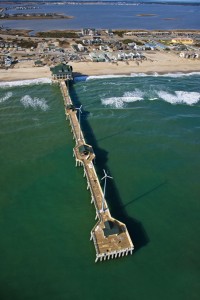By ART LATHAM
A new 1,000-foot, public educational and fishing pier has risen pheonix-like on North Carolina’s Outer Banks.
Jennette’s Pier at Nags Head is due to open to the public on May 21, the state aquariums’ director says.
The pier, at Whalebone Junction near Cape Hatteras National Seashore’s northern entrance, is a unit of the N.C. Aquariums Division and the N.C. Department of Environment and Natural Resources.
Benefitting from current technologies such as hurricane-resistant concrete pilings, the new pier improves upon the storm-battered, all-wooden structure — Jennette’s Pier — that occupied the site for 70 years, until Hurricane Isabel smashed into it in 2003.
Billed as a “one-of-a-kind educational ocean pier” by the not-for-profit N.C. Aquarium Society — the support organization for the state’s three aquariums — the pier’s uses will stretch beyond most ocean piers’ fishing and beach access.
“It will also offer educational exhibits and programs on the ocean and coastal environment, and how we impact it,” David Griffin, N.C. Aquariums director, explains.
As an educational bonus, the traditionally timber-planked pier includes energy features to demonstrate how to live more sustainably and in a more environmentally friendly manner. The complex holds international “green building” certification for leadership in energy and environmental design, he says.
Environmentally friendly details include three pier-mounted wind turbines, solar panels on a shade pavilion, closed-loop geothermal pier-house heating and cooling from 80 wells that each are 200 feet deep and a reusable wastewater treatment system with rainwater cisterns. Such cisterns have been used for generations on the Outer Banks, where drinkable water often can be scarce.

The new pier, with its electricity-generating wind turbines, from a gull’s perspective. Photo courtesy N.C. Aquariums.
The complex also includes a two-story, 16,000-square-foot pier house, with educational classrooms and programs, alternative energy demonstrations, live animal exhibits, meeting facilities, a snack bar and tackle shop.
Mike Remige, Jennette’s Pier’s manager, will report to Maylon White, N.C. Aquarium on Roanoke Island’s director, Griffin says.
The idea for repurposing the former Jennette’s fishing pier got a boost from the 2006-07 N.C. Waterfront Access Study Committee’s report, which noted a precipitous decline In the number of North Carolina’s coastal public fishing piers in the past three decades. Constant beach erosion, other damage from the elements and rising operating costs made it hard to run a viable business at the site.
“True working and recreational waterfronts should be retained to provide an affordable recreational access for thousands, including both North Carolina citizens and visiting tourists,” says Mike Voiland, North Carolina Sea Grant director, who was the committee’s chair.
“The report also noted that public pier development efforts should not — intentionally or unintentionally — further diminish the number of private piers along the shore,” he says.
The N.C. Aquarium Society had planned two more new hurricane-resistant, concrete, public ocean piers: one at Emerald Isle, relatively near Pine Knoll Shores Aquarium, and another at Carolina Beach, near Fort Fisher Aquarium.
The Emerald Isle pier’s design is due later this year, thanks to financing from the N.C. Waterfront Access and Marine Industry Fund. However, funds are not available for the Emerald Isle pier’s construction, Griffin says. Two state grants have allowed property acquisition to begin at the Carolina Beach site.
Jennette Pier’s website provides the following history: Jennette’s was the first fishing pier on the Outer Banks when it opened in 1939. The Jennette family acquired the South Nags Head property, a former “transient camp,” built in 1933 by the U.S. Civil Works Administration to house some of the 1,500 workers who constructed protective sand dunes from Corolla to Ocracoke.
The Jennette family had the camp’s numerous cabins renovated to make convenient housing for anglers who traveled great distances to fish on the pier.
This article was published in the Spring 2011 issue of Coastwatch.
For contact information and reprint requests, visit ncseagrant.ncsu.edu/coastwatch/contact/.
